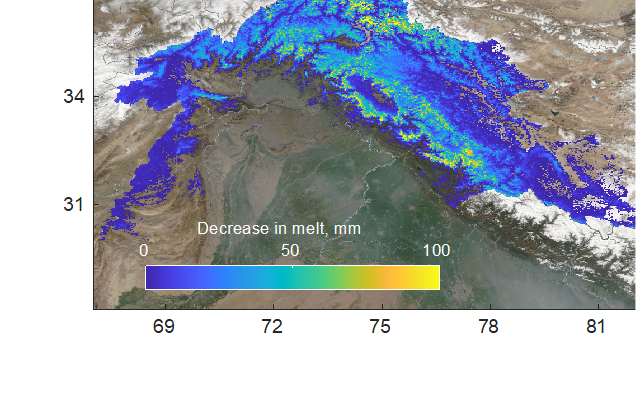This project developed a suite of satellite-based Essential Water Variables (EWVs) for improved near-real-time streamflow predictions using the ParBal surface energy balance model in the Indus River basin. The snowmelt predictions are fed into USACE's HEC-HMS model system to provide reservoir inflow hydrographs for HEC-ResSim for better managing the Tarbela and Mangla Reservoirs (two major water resources in Pakistan) and the Indus River Basin Irrigation System.
Key Results Include
- Upper Indus River Basin Snowmelt-Runoff HEC-HMS model developed, calibrated, and verified for forecasting inflows for Tarbela Reservoir. This included summarizing the ParBal melt for 49 subbasins and used as input to HEC-HMS.
- The U.S. Army Corps of Engineers transferred and provided demonstrations of several USG-developed, state-of-the-art Indus River specific water resources models to Pakistani Ministries and Agencies to be used in long-term planning and real-time operations of the Indus River Basin and Irrigation System, including Tarbela and Mangla Reservoirs. The simulation models take into account: irrigation demands in Punjab and Sindh Provinces, dam safety concerns, hydropower generation, flood mitigation, and environmental flows.
Selected Publications
- Rittger, K., Bormann, K., Bair E.H., Dozier, J., and Painter, T., Evaluation of VIIRS and MODIS snow covered fraction in High Mountain Asia using Landsat 8 (2021), Front. Remote Sens, doi: 10.3389/frsen.2021.647154
- Bair, E.H., Stillinger, T., Rittger, K., & Skiles, M. (2021). COVID-19 lockdowns show reduced pollution on snow and ice in the Indus River Basin. Proceedings of the National Academy of Sciences, 118, e2101174118. doi:10.1073/pnas.2101174118
- Bair, E. H., Rittger, K., Ahmad, J. A., and Chabot, D. (2020): Comparison of modeled snow properties in Afghanistan, Pakistan, and Tajikistan, The Cryosphere, 14, 331-347, doi: 10.5194/tc-14-331-2020.
decrease in melt from an energy balance model using observed snow/ice cover in 2020 compared to the same snow/ice cover with 20-y mean levels of light-absorbing particles. Background image courtesy of NASA Worldview.
